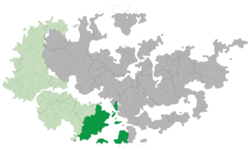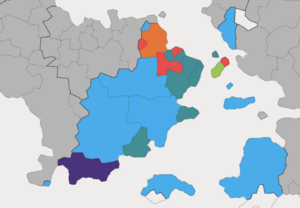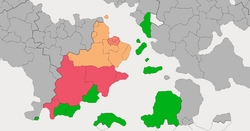Svenskbygderna: Difference between revisions
| Line 488: | Line 488: | ||
|value1 = 58.47 | |value1 = 58.47 | ||
|color1 = #9932CC | |color1 = #9932CC | ||
|label2 = Free Reykjavík Church in | |label2 = Free Reykjavík Church in Beisjørdia | ||
|value2 = 6.75 | |value2 = 6.75 | ||
|color2 = #D470A2 | |color2 = #D470A2 | ||
Revision as of 00:22, 4 July 2020
Ilyçiastical Democratic Federation of Pharexia Pharexian: Kirkjulegt Lýðræði af Fharheckx Astellian: Talamh na n-Oileán go Leor Valian: демократия умов | |
|---|---|
Motto: "To dwell together in unity" Pharexian: "Að búa saman í einingu"" Astellian: "Cónaithe le chéile in aontacht" | |
| File:Pharexia Map Detail.png | |
| Capital | Breíddalsvík |
| Official languages | Pharexian Astellian Valian |
| Ethnic groups (2019) | 38% Asteillian 23% Mainland Esevær (10% Angshirian, 6% Valian, 3% Eustaki) |
| Religion | Church of Pharexia |
| Demonym(s) | Pharexian |
| Government | Confederal multi-party consociationalist directorial republic with significant elements of direct democracy |
• Federal Councilors | Hansine Karlson Aðalheiður Böðvars |
| Legislature | Federal Legislature |
| Cantonal Assembly | |
| National Assembly | |
| Population | |
• 2017 estimate | 2,730,536 |
• Density | 521/km2 (1,349.4/sq mi) |
| GDP (PPP) | 2017 estimate |
• Total | $130 billion |
• Per capita | $49,451 |
| Gini (2017) | 28.95 low |
| HDI (2019) | very high |
| Currency | Pharexian Sherbornes |
| Date format | dd/mm/yy (NG) |
| Driving side | right |
| Calling code | +54 |
| Internet TLD | .phx |
 Map of Pharexia (dark green) in the Esevær Alliance (light green) | |
Pharexia, officially the Ilyçiastical Democratic Federation of Pharexia (pronounced: /fərɛziɑ/; Pharexian: Kirkjulegt Lýðræði af Fharheckx pronounced: [kiɒkju:lɛgd l ʁɛ:i af hɑjɛgss], Astellian: Talamh na n-Oileán go Leor pronounced: [ˈfɒːbɔnˀ æˀ kʰʁ̥yˈlænd̥ə], Valian: демократия умо), commonly referred to as the Federation of Pharexia or the Pharexian Federation, is a Eseværian[1] nation consisting of the southwestern portion of the Sofjord mainland[2], the western portion of Djupivogur Island, in addition to several surrounding islands. It shares mainland borders with Fjerholtia to the northwest and Selsoykenia to the southwest. Eastward, across the Passäcaglia Sea, Pharexia controls a small portion of land on the Vivorian mainland which borders Klyasilia to the southeast, the city-state of Trelisfieldia to the northeast, and Susonia to the west.
Pharexia is a semi-direct democratic federal republic. Its institutional organization is complex and is structured on both regional and linguistic grounds. It is divided into three highly autonomous regions, four language areas, and 21 cantons, each with some degree of semi-autonomous devolved administrations. The capital city of Breíddalsvík is located on the northeastern part on the coast of the Passäcaglia Sea. Most of Pharexia’s terrain is flat with the exception of its mountainous border western border.
Modern-day Pharexia came into being following the dissolution of the Socialist Republic of Pharexia in 1899 after an unsuccessful coup by anti-revisionist members of the Communist & Workers' Party. The Liberal Democrats and the National Unity Party (two pro-democracy political parties) established a caretaker government to assist in Pharexia's transition from authoritarianism to democracy.
Culturally, Pharexia's relatively small population of 2.7 million demonstrates a cohesive national character. Pharexia is a combination of individualism and egalitarianism. Pharexians are highly agreeable and compassionate people, reflected in the state's strong social welfare system, while also harboring conscientiousness and responsibility, reflected by the high GDP per capita, high level of educational achievement, and more recently significant technological advancements.
Pharexia has been described by scholars as an eclectic amalgamation of both conservative and liberal ideologies: for example, despite having rather restrictive abortion laws, it has relatively liberal LGBT laws. This dichotomy is usually attributed to the rather unique teachings of the state church, the Church of Pharexia, which has both a high adherence and a large influence over public policy. Pharexia maintains a Nordic-like social welfare system that provides universal health care and tertiary education for its citizens. Pharexia ranks high in economic, democratic, social stability, and equality. It is consistently ranked as one of the most developed countries in the world and high on the Global Peace Index. The northern third of Pharexia–home to over half of the country’s citizens–runs almost entirely on renewable energy.
Despite the nation being known for its state of neutrality, this has been questioned in recent years, with Pharexia becoming a member of the Esevær Alliance[3] in 2017. Though Pharexia is philosophically and constitutionally a pacifist country, it continues to maintain a minimal defense force that consists of a coast guard and national guard.
Etymology
It is thought that "Pharexia" is derived from an Old Pharexian word for 'mountain healer', a reference to a medicinal herb found in the country's modern-day western border with Selsoykenia. This flower is believed to have been used by native Pharexias to treat influenza, which is known to be an interesting fact used by the tourism industry. The name for “Breíddalsvík”, the capital city, is thought to have come from an old Duxnusaric word for 'wooded', a reference to the city’s former densely forested landscape.
History
Antiquity (Before 7th Century CE)
The first recorded settlement of Pharexian territory is Rifjordur (located in modern-day Sojord) around 8000 BCE. Between 8000 and 5000 BCE, early inhabitants used stones to make tools and weapons for hunting, gathering and fishing as means of survival. Primitive structures were eventually erected, indicating an important shift from nomadism to sedentism. Sheep, moose, and red deer were known to roam freely in the forest and were a common source of food for proto-Pharexians. Agriculture was likely brought to the settlement by invaders from what is now Fjerholtia, as the inscriptions written in the region’s ancient tribal alphabet are found in the area's early agriculture sites. The settlement had evidence of cherry and sheep farms, and there have been cave paintings showing similar animist undertones. These settlements grew in the subsequent years, and around 3000 BCE there were many small settlements dotted around the northern forests and into the upper southern plains.
Neighboring tribes of modern-day Selsoykenia began interacting with the Rifjordur settlement, and the two exchanged knowledge of pottery, agriculture, and it is believed this is what spurred the development of the ancient Astellian language.
Settlements grew quickly in the north regions due to their proximity to the Passäcaglia sea, ease of irrigation for their crops, and the high fertility of the land. In this time of agricultural development the various bands of people began consolidating into large tribes. The largest and by far most well known of these was the Angshire tribe, who developed the first nation state of Pharexia. Through a series of conquests and marriages, the Angshire tribe would come to control much of the southwestern portion of the Sofjord mainland.
The Angshire Era (700CE to 1000CE)
By the end of the 8th century, the Angshire tribe consisted of many small, organized communities governed by independent things. These things served many roles: as proto-parliaments, proto-courts, and for public religious rites. However, over the next 50-100 years, a feudal system was implemented which the royal family would lease land to roughly 100 wealthy families and would give them the title of lord families. These lord families would then lease lands to baron families who would lease them to peasants. Due to the Passäcaglia Sea that seperated the two nations, Pharexia was largely spared from Klyasilian invasions, as the Klyasilians had only very small, rudimentary boats.
Around 800 CE, a large army of invaders from the Valian Kingdom successfully annexed most of northern Pharexia, ending the Angshire tribe's 300 year claim to the region. At this point in time, the Valian Kingdom covered most of the Sofjord mainland. A major civil war broke out in the Valian Kingdom in 1424 CE when King Teodaria III's twin sons fought for the right to rule. The war resulted in the death of Prince Gallio and began the reign of King Litio I.
Medieval Era (1021CE to 1543CE)
The Barony of Holafsosan (1021CE to 1301CE)
The Great Civil War (1301CE to 1313CE)
The Pharexian Confederal Monarchy (1313CE to 1543CE)
Industrial Era (1500CE to early 1800CE)
The Rough Times (Late 1700CE to late 1800CE)
The Rough Times (Pharexian: erfiðleikum, Astellian: deacrachtaí, Valian: сложно) were a period of increased tension between the various sects of Phrexian branches of Ilycisianism that arose during the enlightenment. Though no fracturing of the nation like during the Great Civil War occurred, there was widespread violence and disorder spread in this time. In power political parties became seen as either unwilling or unable to deal with the problems, causing a large desire for sweeping political change in the general population. It was early on during this period that a large swath of land was purchased from Susonia in order to help alleviate tensions by giving minor sects new land to settle. This pseudo-colonization program was widely unpopular among the general population due to its heavy drain on monetary resources and was unsuccessful in reducing sect tensions. The economic hit the country took from this purchase and the unhappiness with established parties would go on to lead to the rise of new parties that were farther to the left and right than usual in the country.
Socialist Revolution (1869CE)
- Main article: Pharexian Socialist Revolution
Following the enlightenment, many Pharexians no longer supported the monarchal system of governance. There was also frustration among Pharexian mill workers and peasents due to persistant low pay and dangerous working conditions. During 1869, a series of worker-led insurrections occured throughout the country, with hundreds of mills and farms being "liberated". The Monarchy, the military, and the Federal Legislature were also overthrown after refusing to negotiate with the newly formed Bloç Fharheckx (BF). This insurrection resulted in the formal establishment of the Socialist Republic of Pharexia on December 20, 1869, with Andres Knudson ascending to the newly established office of General Secretary of Pharexia. Shortly after seizing control, the Pharexian Communist & Workers' Party was organized and declared the only legal political party in the country.
The Socialist Republic of Pharexia (1869-1898CE)
- Main article: Socialist Republic of Pharexia
In the years after the socialist uprising, Pharexia saw an increase in violence against the weathly, landowners, and leaders of religious communities. Many key members of the original insurrection were purged by Knudson as he futher consolidated his power. Despite promises to the contrary, Pharexia saw little economic growth and famines were still common, especially in the south and east. Knudson increased international interest in the Pharexian economy, but little was felt by the public, who remained furious over continuing requisitioning of grain. Over the next five years, Pharexia continued to veer towards an authoritarian model of governance. Members of the Verkalýðsþing, originally elected by union members, became hand-picked by Knudson. In 1875, Knudson dissolved the council entirely.
In 1892, Pharexia was hit with a deadly epidemic of influenza that resulted in the deaths of over 200,000 people, which at the time was approximatly one-fifth of the country. It is believed that people were especially suseptible to the virus due to widespread emaciation and the lack of clean water outside of Breíddalsvík and Sojord. Only a month after the virus had been identified, Knudson and half of his inner circle had died.
Without Knudson's leadership, infighting broke out among the party executives. Cryło Maouzía, who supported liberalization of the economy, was reluctently chosen to succeed Knudson after the other two contenders died of influenza.
Upon taking office, Maouzía embarked on an ambitious program of reform involving major economic and political restructuring. He reinstated the Verkalýðsþing and gave them greater authority over domestic affairs. He also divided the county into three regions: north, south, and east, and gave a degree of autonomy to each. He said this was to allow for quick, local decision-making intended to slow the influenza's spread and better allocate resources, both of which it did. Although all members of the republic and regional government were still hand picked by the General Secretary, many citizens were pleased with the reforms. Upon taking office, Maouzía reinstated the Verkalýðsþing and gave them greater authority over domestic affairs.
By the mid 1890's, free elections were introduced in the east and western regions, ending the one-party rule that the Workers' Party had enjoyed for nearly twenty years. Strict socialist ideologues in the Party were furious with Maouzía for allowing the general population to take part in the democratic process and he lost the support of many Party executives. However, Maouzía retained high approval from the citizenry.
On 6 June 1898, Maouzía was assassinated by a Party member during a signing ceremony for democratic reforms in the north and capital district. It is believed the assassin was a hard-line opponent of Maouzía's reform program and was supplied by Workers' Party leaders. Despite the Party's intention to then take back control, the event destabilized Pharexia and is widely considered to have contributed to both the demise of the Workers' Party and the dissolution of the Republic.
The vacuum of power was seized by the Southern region's pro-democray government. One of their first actions was to formally dissolve the Socialist Republic of Pharexia and establish a democratic federation.
Modern Era (1899 CE - present)
Democratic Reforms (1899-1905 CE)
In 1900, an assembly was commissioned by the Liberal Democrats and the National Unity Party to write a new constitution, consisting of delegates from all major parties and delegates from each canton and region. The new constitution, known as People's Law, declared that a council would take over the role of the executive and head of state; this council was to have five members and be divided between the main political forces in the nation to ensure peaceful co-operation between the main forces. The new nation was also to have elements of direct democracy, in that referenda could be held if a petition with a certain number of signatures called for one, and that any citizen could petition to have a referenda on every law. A bill of rights that guaranteed the rights of all Pharexia was incorporated, which was to be of the utmost importance in the constitution. Representation was also guarenteed to members of the country's three largest language groups.
Contempory history
Contemporary Phaxian history has been dominated by liberalization of the market. The government prioritized privatising a number of state-owned companies. Economic stability increased and previously chronic inflation was drastically reduced.
Geography
Climate
| Pharexia | ||||||||||||||||||||||||||||||||||||||||||||||||||||||||||||
|---|---|---|---|---|---|---|---|---|---|---|---|---|---|---|---|---|---|---|---|---|---|---|---|---|---|---|---|---|---|---|---|---|---|---|---|---|---|---|---|---|---|---|---|---|---|---|---|---|---|---|---|---|---|---|---|---|---|---|---|---|
| Climate chart (explanation) | ||||||||||||||||||||||||||||||||||||||||||||||||||||||||||||
| ||||||||||||||||||||||||||||||||||||||||||||||||||||||||||||
| ||||||||||||||||||||||||||||||||||||||||||||||||||||||||||||
The climate of northern Pharexia is temperate and covered in deciduous forest while middle and southern Pharexia is largely taiga grassland. Temperatures average between 5°C (41°F) in the north and -1°C (30 °F) in the south throughout the year. As a result of the moderation and the southernly latitude, summers normally hover around 12 °C (53 °F). Average temperatures are -7 °C (19 °F) in winter. The southernly latitude location also results in perpetual civil twilight during summer nights and very short winter days.
Nature
When Pharexia was first settled, it was extensively forested, with 80% of the original land covered in trees. In the late 17th century, permanent human settlement had greatly disturbed the isolated ecosystem. The forests were heavily exploited over the centuries for firewood and timber. A 1987 government assessment found only 12% of the original forests remained. Deforestation, climatic deterioration, and overgrazing by livestock imported by settlers caused a loss of critical topsoil due to erosion. The issue has recently gained significant attention at the state and federal level. The left-wing environmentalist political party Green–Left has put forth several legislative proposals in recent years to halt all remaining logging operations in Pharexia and require all raw wood be imported. The ruling Conservative Party, while criticizing the proposal as "impractical", passed legislation in 2015 requiring logging companies to replant two trees for every one they cut down.
Government and politics
Pharexia is a federal multi-party directorial republic comprised of four language communities, three regions, and 21 cantons. For each of these subdivision types, the subdivisions together make up the entire country; in other words, the types overlap.
The country's government is based on the 1900 constitution, People's Law (Pharexian: Folkslov, Astellian: Qunnerit, Valian: Народный закон), which defines how the government's branches work and how they interact with one another and protects the civil rights of the population. Amendments to the constitution require a 75% majority in the Federal Legislature or the approval of 16 out of 21 cantons, accompanied by a public referendum. The constitution has been amended five times; in 1905 to abolish the death penalty, in 1964 to change the electoral system of the Federal Legislature's lower house from a FPTP system to STV, in 1977 to change the Federal Council from 5 members to 6, in 1979 and enshrine Pharexia's universal healthcare system, and in 2017 to add a seventh and eighth position on the Federal Council. There are three major branches of the federal government: the bicameral Federal Legislature holds legislative power, the eight-member Federal Council holds executive power, and the High Court of Justice holds judicial power.
Executive
The Federal Council of Pharexia (Pharexian: Sambandsríki, Astellian: Cónaidhme, Valian: совет) is the executive branch, consisting of eight councilors. One of the councilors is labeled as the ceremonial Head Councilor (Pharexian: Seansailéir, Astellian: Ceannasaí, Valian: лидер) for the year, and another is labeled the Vice Councilor (Pharexian: Seasmhack, Astellian: Staðgengill, Valian: ассистент). Each member except the Head Councilor is in charge of one of Pharexia’s seven large government departments dealing with broad policy fields. The Council itself is based on ideas of consociationalism, in which the main political parties of Pharexia share out the seats within the council, a tradition that has been maintained since the beginning of the country and relies on pragmatism between the parties. Currently, the Conservative Party and the Science–Moderate Party hold two sets each while the Ilyçisian Democrats, Liberal Party, and New Future hold one seat each. One member of the Council is unaffiliated.
| Position | Picture | Name | Party | |
|---|---|---|---|---|
| Head Councilor of Pharexia (Seansailéir/Ceannasaí/лидер) |

|
Hansine Karlson DLJ[4] | Conservative Party | |
| Vice Councilor of Pharexia, Councilor of Defense and Immigration (Seansailéir/Ceannasaí/ассистент, Innanríkismáladeild/Inimirce/Оборона) |

|
Aðalheiður Böðvars | New Future | |
| Councilor of Health and Social Care (Dochtúireachta/Culgarmálarádherra/Советник) |

|
Karoline Fleischer DM[5]FPPH[6] | Science–Moderate Party | |
| Councilor of Foreign Affairs (Utanríkismáladeild/Gnóthaíerra/Иностранные) |

|
Sir Ole Møller | Ilyçisian Democrats | |
| Councilor of Culture and Religion (Sjávarútvegi/Eaglaiscultúr/религия) |

|
Arne Egede | Unaffiliated | |
| Councilor of Finance and Economic Affairs (Sjávarútvegi/Airgeadais/финансов) |

|
Isak Petersen DLJ | Conservative Party | |
| Councilor of Transport, Infrastructure, the Environment (Velferðarráðuneytið/Gníomhaithe/инфраструктура) |

|
Pavia Knudson | Liberal Party | |
| Councilor of Justice and Equality (Dómsmálaráðuneytið/Oidhreachta/юстиция) |

|
Nja Johansen DLJ | Science–Moderate |
Legislature
Legislative power is vested in the bicameral Federal Legislature (Pharexian: Síðari, Astellian: Félagið, Valian: законодательная). The lower chamber is the 274-seat People's Assembly, and the upper chamber is the 63-seat States' Assembly. The houses have identical powers. Members of both houses represent the states, but, whereas seats in the National Assembly are distributed in proportion to their population using open-list proportional representation, each state has three seats in the States' Assembly, which are elected using single transferrable vote. Both are elected in full once every four years on the 1st March, with the last election being held in 2018.
The Federal Legislature possesses the federal government's legislative power, along with the separate constitutional right of citizen's initiative. For a law to pass, it must be passed by both houses. The Federal Legislature may come together as a United Great People's Legislature in certain circumstances such as to elect members to the Federal Council and justices to the High Court of Justice.
Judicial
The judicial branch plays a minor role in politics, apart from the High Court of Justice (Pharexian: Réttlæti, Astellian: Lagâleg, Valian: Судья), which can annul laws that violate the freedoms guaranteed in the constitution. The Federal Legislature, in a joint session, creates a list of legislative appointees to the High Court, with the Federal Council choosing from that list. The HCJ has 5 members.
Federal laws
- Main article: Overview of federal laws in Pharexia
The Pharexian Federation is home to a belief in personal and more recently digital privacy, a high degree of public safety and a complex social insurance scheme mixing private and public funding. Pharexia has strict gun control laws: a national government safety course must be passed, a special license is required to own a handgun which may only be used for target shooting at a licensed range, semi-automatic firearms have caliber restrictions, while fully automatic firearms are banned entirely. Most psychotropic substances, such as alcohol, marijuana, and cocaine, and other class A drugs have been decriminalized but are believed to be rarely used.
Politics
- Main article: List of political parties in Pharexia
Pharexia is home to a diverse slate of political parties. Pharexia was rated a "full democracy" in 2019.
| Party | Votes | % | ±% | Upper Seats | Lower Seats | Upper ± | Lower ± | |
|---|---|---|---|---|---|---|---|---|
| Conservative Party | 375,380 | 23.5 | 18 | 61 | ||||
| Science–Moderate Party | 241,201 | 15.1 | 15 | 42 | ||||
| Liberal Party | 191,683 | 12.0 | 9 | 33 | ||||
| Ilyçisian Democrats | 167,723 | 10.5 | 6 | 28 | ||||
| Centre Party | 126,191 | 7.9 | 0 | 22 | ||||
| Greens–Left | 115,010 | 7.2 | 5 | 20 | ||||
| New Future | 99,036 | 6.2 | 8 | 17 | ||||
| Dignity–Solidarity Party | 70,284 | 4.4 | 2 | 8 | ||||
| Forward | 63,894 | 4.0 | 0 | 11 | ||||
| Lofogengenlok Independence Party | 43,128 | 2.7 | 0 | 8 | ||||
| Unaffiliated | 103,828 | 6.4 | 0 | 27 | ||||
| Invalid/blank votes | 15,974 | – | – | – | – | – | ||
| Total | 1,597,364 | 100 | – | 63 | 277 | – | – | |
| Registered voters/turnout | 2,047,902 | 78.0 | – | – | – | – | – | |
Regions, communities, and cantons
Pharexia has a complex system of national division. These assist with the institutional, cultural, and territorial organization of Pharexian territory.
| Federal state | 1 | |||||||||||||||||||||
| Regions | 3 | |||||||||||||||||||||
| Communities | 4 | Pharexian | Bi-lingual | Astellian | Valian | |||||||||||||||||
| Cantons (ID) | 21 | FE | HA | LK | LO | LV | RG | SJ | TR | BR | HE | CE | DY | OS | VO | MA | SA | SO | BE | GA | HV | ST |
The highest order of division is done by geography, which splits the country into three "regions" (Pharexian: svæði, Astellian:limistéar, Valian: площадь)
- the Northern region: is composed of the capitol canton, surrounding suburbs, and other nothern areas. It is the most populated region in the country with over 65% of all Pharexian citizens residing here. Its citizens tend to tilt towards liberalism and are less likely to be religiously affiliated with Ilyçisianism, especially Sólheimaka. It is the only region with embedded bi-lingual speaking communities.
- the Southern region: known for its relative remoteness, conservatism, and religiosity, being considered the hotbed of Sólheimaka (Orthodox) Ilyçisianism in Pharexia. 32% of Pharexians reside here.
- the Eastern region: is composed of all cantons and territories not apart of mainland Pharexia (with the exception of Reika Grav, apart of the North). It is by far the least populated region with only 7% of Pharexians residing here.
Each region has their own devolved legislature and a 5-person executive council, akin to the Federal Legislature and Federal Council’s structure respectively. Regions are able to legislate on matters that have not been reserved for the federal government.
The second-level of administration is based on language-speaking communities (Pharexian: tungumálumælandi, Astellian: labhraítear teanga, Valian: языковые сообществ) of which there are four:
- the Pharexian-speaking community
- the bilingual Pharexian-Astellian-speaking community
- the Astellian-speaking community
- then Valian-speaking community
Pharexia is officially a triingual nation: the three languages of Pharexian, Astellian, and Valian are recognised as equal official languages nationwide, but are not regularly spoken outside their designated community. The four language-speaking communities are each afforded a 5-person executive council. Language-areas do not have legislative autonomy from the regions they are in.
The third-level of administration, known as cantons (Pharexian: rijords, Astellian: bharda, Valian: кантон), are based around population centers and cities, of which there are 21. Cantonal governments consists of two main branches: the Cantonal Council, which is the unicameral elected body, and the Cantonal College, which is the 3-person executive body. One member of the College is appointed by the regional government (i.e. the Northern, Southern or Eastern Government), while the other 2 are directly elected via the populous. The size of the Cantonal Council, on the other hand, varies based on each canton's population. Together, these two branches are responsible for the functioning of local courts, public utilities, libraries, hospitals, public health services, parks, roads, law enforcement, and jails. They prepare and processes certificates of births, deaths, marriages, and dissolutions. The cantonal recorder normally maintains the official record of all real estate transactions. Other key officials include the medical examiner, treasurer, assessor, auditor, and comptroller.
The cantons of Gæcadoia and Lofogengenlok are notable exceptions. Gæcadoia is a geographically expansive and sparcely populated canton and much of its functions are managed by the Eastern region government. Lofogengenlok is the only fully autonomous region and self-governing part of Pharexia, officially deemed as such after the 1934 Pharexian–Lofogengenlok reunification. Lofogengenlok, originally a Pharexian canton (now referred to as a "autonomous canton" located in the Northern region), had in 1521 declared itself an independent country. While Pharexia never officially recognized this claim, Pharexian foreign policy had largely treated it as a separate country until negations warmed during the Second Great War. As of 2020, Pharexian federal law does not generally apply in the region and Lofogengenlok is treated as a separate jurisdiction, although there is continued debate regarding its independence from the Northern region's laws. It’s head of state is currently Queen Melisende III, and Lofogengenlok has its own legislature, the Legcø.
Defense
The military of Pharexia consists solely of the Coast Guard (Pharexian: Varnirliðið, Astellian: Glijbaan, Valian: Береговая) which patrols Pharexian waters. The country is one of few who has no standing army.
The Coast Guard is based upon a small core of professional volunteers. If necessary, it can field up to 200,000 soldiers of fighting age in the case of a ground invasion. For obvious reasons, this is unsustainable in any other situation, and so the regular strength of the Coast Guard is closer to 20,000 professionals and militia. The military's role is purely defensive. They have yet to engage in battle either overseas or within the Pharexia.
Economy
Economically, Pharexia is a competitive and highly liberalized, open market economy. Most Pharexian enterprises are privately owned and market-oriented. This is combined with a strong welfare state. Pharexia has generous maternity/paternity leave, government-funded job training, and a free healthcare system. While public spending was estimated to be 25% of GDP in 2019, this percent has been stedily declining for nearly five decades. Public-held debt has more than halved from 50% of GDP to 22%. Much of this is because private companies are now able to provide public goods by competing for contracts alongside public providers (such as in healthcare and education). Since the major wave of liberalization in the mid-1940's, savings haven't changed much and there is still continued debate about if private firms are able to the same quality as public-run services. However, since the fall of the Communist government of Pharexia's state-run economy in 1899, standard of living, life expentency, and self-reported happiness has increased substantially.
The Pharexian economy is heavily reliant on both imports and foreign investment. Global shocks are apt to have a disproportionate effect on Pharexia, therefore. Pharexia has no significant natural resources apart from fish, sheep, and cherries, and has a high degree of economic specialisation.
Finance contributes to around 25% of the economy, by far the largest single sector. It is based around a strong banking sector which is a mix between secrecy and strict regulation, and social responsibility. Banking secrecy laws are extensive and enforced strictly. Research and development makes up around 12% of the economy and is geared primarily towards high-value and high-tech electronics, mechanical engineering, chemical engineering and armaments. Armament development accounts for 4% of the economy, directed primarily towards moderately sophisticated equipment designed to match but not exceed the capabilities of foreign-made products. Ship-building accounts for 4% of the economy as well, and works in close conjunction with the armaments industry. Luxury goods account for 3% of the economy. A lot of it is not designed for export (such as tailors) and others are usually small artisans rather than large chains (watchmakers and fashion). Tourism accounts for 7% of the economy, and this is split between 'cultural tourists' who come for the history and odd culture of Pharexia, and 'luxury tourists' who come to visit the wine bars and stay in luxury hotels. Brewing and distilling accounts for 4% of the economy and is based around ale, rye whiskey, gin and unique Pharexian beverages. Energy production accounts for 6% of the economy and is focused on dynamic tidal, hydro-electric and geothermal. The majority of this energy is used to power Pharexia itself as the government strives for energy self-sufficiency. Greater export potential comes from the physical power-generation appliances and designs. The remaining 18% is primarily service sector jobs or small-scale manufacturing of high-value high-tech goods.
Infrastructure
Transportation
Transportation in Pharexia is facilitated by road, air, rail, and waterways (via boats). The vast majority of passenger travel occurs by cycling or automobile for shorter distances, and railroad or bus for longer distances.
Driving in Pharexia is a frequent occurrence, with approximately 60% of Pharexians owning private automobiles. Each canton has the authority to set its own traffic laws and issue driving licenses, although these laws have largely been the same since the 1960's. Licenses from other state are respected throughout the country. Pharexians drive on the right side of the road. There are numerous regulations on driving behavior, including speed limits, passing regulations, and seat belt requirements. Driving while intoxicated with alcohol or marijuana is illegal in all jurisdictions within Pharexia.
Most roads in Pharexia are owned and maintained by either the federal, regional, or cantonal governments. National Highways (Pharexian: Ajóðveginum, Astellian: Mhórbhealaigh, Valian: дороги), defined as controlled-access roads spanning 2 or more regions, are federally maintained and subject to federal regulations. Expressways–controlled-access roads existing entirely within a single region–are built and maintained by the region and are likewise subject to regulations set forth by the state. In addition, there are many local roads, generally serving the many of the remote or insular locations of southern and eastern Pharexia.
Cycling
Cycling is a common mode of transport throughout Pharexia, with 45% of the people listing the bicycle as their most frequent mode of transport on a typical day as opposed to the car by 38% and public transport by 21%. Cycling for transport tends to be much lower in rural areas than in urban centers.
Healthcare
Pharexia has a single-payer, universal healthcare system. The system was adopted in 1970 as a part of the creation of the welfare state in Pharexia. It is managed centrally by the Councilor of Health and Social Care, and at the local level by 43 health boards elected every five years by the general populace.
The healthcare system is funded via federal income tax, and it is the largest recipient of money from the federal budget, with around 10% of the entire Pharexian GDP being spent on healthcare. This funding has led to an efficient, well-maintained, well-staffed healthcare system free at the point of use. PHS is thus admired by many, and recent polls in Pharexia have shown that over 85% of the population is supportive of the system.
Mental health has received increased attention in Pharexia in recent years, with mental health funding being increased in response to increased openness around mental health in Pharexia. Recent research has found that significant proportions of Pharexians suffer from conditions such as depression and anxiety.
Education
Both public and private schools exist in the Pharexian Federation. Education is compulsory: federal law ensures that all children attend school until they are at least 18 years old and provides for them to attend further education beyond that age. Schooling does, however, start later than many countries, at 5 years old.
In general Pharexian schools try to instil a desire to learn for the sake of learning, and to pursue what one is interested in simply because it is interesting. A premium is placed on social interaction and emotional awareness, particularly at younger ages, where long break times are included in the school day and much outdoor activity is encouraged. Sports and general physical fitness grows to take up a large part of the timetable in later school years, partly for philosophical reasons but also because Pharexia's competative economy requires a high level of fitness.
Schools are able to give religious instruction according to the beliefs of their religion. It also preserves the right of teachers not to give religious instruction if they so choose, and for parents or guardians to decide whether or not their child will receive such instruction. In general, religious instruction is common simply as a means of broadening the minds of students and teaching them the value of approaching life and other situations from multiple perspectives. This accounts, in part, for the high degree of religiousness amongst the population.
Almost all classes are conducted in Pharexian as a standard. Foreign language classes tend to be conducted in the relevant language being taught, depending on the level of the students. As Astellian is also one of the Federation's official languages and spoken by 82% of the population, some teachers choose to take classes in it so as to improve the speaking skills of their students. This is encouraged as a way of improving Arthuria's ability to interact on the global stage, as Pharexian is spoken almost exclusively by Pharexians only.
Typically, the summer school day lasts from 0800 to 1400, with variation depending on schools. In the winter months, due to extreme temperatures, the school day may start at 0900 and last until 1600 instead, or simply be shortened. Schooldays tend to run from Monday to Friday, so that various religions which take Saturday and Sunday may observe their religious obligations.
Break periods are seen as a vital part of developing students' social skills and emotional awareness, and in all-but extreme circumstances they are required to go outside in these times. In earlier years, break periods take up a large portion of a student's day, to be gradually replaced by physical fitness as their school career progresses.
Religion
Formal religious affiliation in Pharexia (2020)
Ilyçisianism
- Main article: Ilyçisianism
For much of Pharexia's history, Ilyçisianism has dominated the public and private sphere of daily life. The Reykjavík Church of Pharexia (Pharexian: Kirkja hins af Fharheckx, Astellian: Séipéal n-Oileán naofa, Valian: церковь страны), often abbreviated as the KHF) is both the established church in Pharexia as well as the largest denomination of Ilyçisianism, with nearly 60% of the population reported as members. There are smaller Reykjavíkian churches unaffiliated with the Church of Pharexia that make up an additional 15%. Reykjavík and Ilyçisianism have a complex theological, historical, and sociological relationship. While Reykjavík (Reformed) Ilyçisians consider the Endurreisn Heimsins to be scripture, they do not believe in inerrancy or literalism like most Sólheimaka (Orthodox) Ilyçisians do.
Reykjavík theology argues that interpreting Ilyçisian scripture must be informed by scholarship (particularly from psychological, evolutionary, and existential perspectives). Perhaps the largest distinction is that most Reykjavík do not profess a belief in a celestial being. Rather, Reykjavíkians believe that theism has lost credibility as a valid conception of God's true nature. Such a belief is commonly referred to as Ilyçisian atheism. Ilyçisian atheism is a form of cultural Ilyçisianism and ethics system drawing its beliefs and practices from Addindr’s life and teachings as recorded in the Endurreisn Heimsins and other sources, whilst rejecting supernatural claims of Ilyçisianism. In 2005, the book Believing in a God Who Does Not Exist: Manifesto of An Atheist Minister, Reykjavíkian pastor Hendrikse describes that Reykjavík Ilyçisians believe "God is for me not a being but a word for what can happen between people. Someone says to you, for example, 'I will not abandon you', and then makes those words come true. It would be perfectly alright to call that [relationship] God". Hendrikse's views are widely shared among both clergy and church members. Some–especially Sólheimaka Ilyçisians–view the Reykjavíkian denomination as distinct enough from traditional Ilyçisianism so as to form a new religious tradition, although the KHF rejects this claim.
The second largest Ilyçisian denomination in Pharexia is Sólheimaka. Sólheimakans are orthodox Ilyçisians in the sense that they continue to believe in an actual heavenly God, as well as Endurreisn Heimsins literalism. The Church of Sólheimaka is the largest Sólheimaka church in Pharexia, with nearly 8% of Pharexians considering themselves members. An additional 2% are members of smaller, independent Sólheimakan churches.
In total, all Ilyçisians of both the Reykjavík and Sólheimakan denonination make up around 83% of the population. Their distribution is spread relatively equally throughout the country. With the exception of southern Pharexia (~95%), and Breíddalsvík (~45%), the average number of Ilyçisians in each canton stands at approximately 8-in-10.
Among people who identify as Ilyçisians, 50% of them attend weekly religious services, a figure much higher than other religious people in the country. Reykjavík Ilyçisianism is typically classified as a liberal denomination. For example, the Church of Pharexia has long supported gay and lesbian rights. Weekly Reykjavík services do not revolve around worship but rather focuses on deconstructing ancient scripture to extract out philosophical, ethical and theological wisdom that can be applied to the modern day. There is also a strong emphasis on community and fellowship.
Influence of religion
Religion continues to play a significant role in the debate over abortion and physician-assisted suicide in Phareixa. The official Church of Pharexia stance is, "Life, the experiences we gain from being a part of the world and of humanity, are necessary and essential to spiritual fulfillment." This position is shared by most Ilyçisians. The Conservative Party, Science–Moderate Party, New Future, and the Ilyçisian Democrats all oppose abortion and cite Ilyçisian values as their justification.
While Reykjavík Ilyçisianism is officially the state religion, People's Law guarantees religious freedom and upholds equality, no matter one's religious affiliation. In the last census, only 12% of the population identified as having no religion, despite nearly 80% of the country answering that they "do not believe there is any sort of spirit, God, or life force". This strangely makes Pharexia one of the most religious and secular countries in the world. A released in 2016 indicated that only 42% of Pharexians would vote for an openly theistic candidate. This is up slightly from 36% and 40% in 1987 and 1999 respectively.
Statistics
According to a 2016 poll:
• 8% of Pharexian citizens responded that "they believe there is a God".
• 16% responded that "they believe there is some sort of spirit or life force".
• 62% responded that "they don't believe there is any sort of spirit, God or life force".
• 14% gave no response.
According to 2018 data from annual social-cultural study, 40 percent of Pharexians responded with "No" to the question to the question "Do you believe in God?", while 6 percent said "Yes" and 54 percent said that either they did not know or that the question was “difficult to answer”. Follow up questionares have found that while over 80% of Pharexians do not believe in a "literal, celestial supreme being", nearly 75% believe that they believe in a "higher order or calling" that is "synonymous with the idea of God". The survey also showed that 7-in-10 Pharexians say religion is an important part of their lives, which is notably higher than other developed nations.
- ↑ The world's western-most continent; it stretches from Comking to Pharexia.
- ↑ The southern landmass of the Eseværian continent.
- ↑ A political and economic union consisting of all 7 Eseværian nations and the city-state of Trelisfieldia (not located on the Eseværian continent).
- ↑ Doctor of Law and Justice
- ↑ Doctor of Medicine
- ↑ Faculty of Pharexian Public Health














